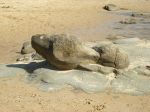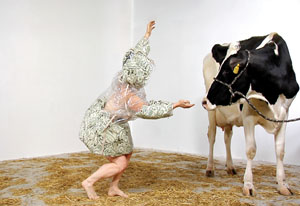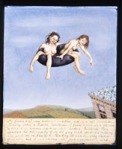Last night, Ed, Sheila and I were having a lovely dinner outside on the water at Boston’s Institute of Contemporary Art after a “tasting” event that I’d give mixed reviews..or, even, a pan (so to speak).
It was the third of four gourmet “tastings” sponsored by the national law firm Eckert Seamans, which has an office in Boston.
In June, Ed and Sheila had enjoyed a tasting given by Ana Sortun, owner of Cambridge restaurants Oleana and Sofra, who, the ICA says, is one of the country’s “best creative fusion practitioners.” Combining farm-fresh, organic ingredients from Siena farms, and eastern Mediterranean spice blends, Sortun prepared wonderful samples that, Sheila said, “you could die for.”
I’d been to a tasting the previous week, which featured cocktails and commentary by “Drink” bartender John Gertsen, (who could write a PhD thesis on the history of the martini) and canapes from Barbara Lynch Gruppo, with Colin Lynch. Both are new establishments founded by restaurateur Barbara Lynch.
Last week’s tasting featured Deirdre Heeking and Caleb Barber, the author and chef, respectively, who own and run Pane e Salute in Woodstock, Vermont, which the ICA billed as “a stylish, classic Italian tavern, inspired by and celebrating the regional variations of Italy. Using local ingredients, they present surprising, marvelous, and essential dishes full of the spirit of Italy and the bounty of each season.”
- The first sampling was dandellion greens with olive oil and lemon juice.
- The second sampling was dandellion greens with oil, garlic, and something that made the greens taste less tart.
- The third sample was dandellion greens with olive oil, and topped with pancetta.
- The fourth was… you guessed it: dandellion greens–this time with cheese, tomatoes, salt, pepper, garlic, and white wine, which Caleb cooked as he spoke rapturously about Italian meals designed to lengthen life and olive groves in the town where he and his wife had often stayed.
I liked the romantic, if “overbaked”, passages Deirdre read from the owners’ new book. Ed was taken with the discussion and enjoyed the food. Sheila and I agreed that the price of both the greens and admission, for members, was right (free). We liked the bread, but thought that the samples all looked like overcooked spinach and tasted like…um… kale.
Although the handout suggested serving sample #4 as a main course, Sheila said: “Maybe it would be better to serve it in small batches, along with other things.” I asked, “Why would you serve it at all?”
After Deirdre described two luscious-sounding wines that we never got to taste, we decided to skip the question period and head for the cafe.
Sheila loved her “naan of the day” (an Indian bread served with spiced beef ), Ed his sandwich (roast turkey with lettuce, tomato, avocad0, mustard aoli and cheese ) and I my Arctic char salad, with lettuce, tomato cumber salad (each $9.oo before the 10% member discount).
We were happily watching the sun set over the water, a tall ship making its way across the harbor, and party cruisers against the beautifully lit Boston skyline when Ed, who had so enjoyed the samples (hey–or should I say “hay”– he loves kale) suddenly remembered that he’s allergic to dandelions–as he found once out the hard way when drinking dandellion tea . (It can cause diahrrea). At that point, we hit the rest rooms (just in case), then headed home.
None of us had any adverse reactions. We do wonder at Heekin and Barber’s choice of samples…which were not the greatest promo for what is probably a wonderful restaurant.
But we’re looking forward to next week’s tasting with John McClellan, proprietor of Boston’s award-winning L’Espalier and Sel de la Terre–both of which, the ICA Web site says, feature regional ingredients combined with the culinary traditions of France.
c. Anita M. Harris
More on dandelion greens:
I checked the Web and found the following , which I’ve lifted from http://www.bellaonline.com/articles/art9837.asp: because I wasn’t able to find the info at the US Department of Agriculture Web site.
According to the U.S. Dept of Agriculture, dandelions are more nutritious than broccoli and spinach, contain more cancer-fighting beta-carotene than carrots, and are a rich source of calcium, iron, magnesium, potassium, thiamine, riboflavin, lecithin, and dietary fiber.
Dandelions cleanse the bloodstream, liver and increase the production of bile. A natural diuretic they reduce serum cholesterol and uric acid. They help functioning of the kidneys, pancreas, spleen and stomach, and can be useful for abscesses, anemia, boils, breast tumors, cirrhosis of the liver, fluid retention, hepatitis, jaundice, age spots and rheumatism.
Dandelion flowers are an excellent source of lecithin, a nutrient that elevates the brain’s acetylcholine, a substance that helps maintain brain function and may play a role in slowing or even stopping the progression of Alzheimer’s disease. Lecithin also helps the body maintain good liver function, so it is no surprise that dandelion is widely recommended by herbalists and naturopathic physicians for liver detoxification.
Native Americans used it to treat kidney disease, indigestion, and heartburn; traditional Arabian medicine prescribed it to treat liver disease; and Traditional Chinese Medicine (TCM) uses dandelion in combination with other medicines to treat hepatitis and upper respiratory tract infections, including bronchitis and pneumonia
However (my ital) dandelion may cause allergy to certain people. People who are allergic to chamomile, yarrow or other related plants should use dandelion with caution. If you are taking lithium, insulin, anti-coagulation, anti-diuretic or blood-sugar controlling agents, consult with your doctor, first.
New Cambridge Observer is a publication of the Harris Commmunications Group of Cambridge, MA, as is www.harriscomblog.wordpress.com.





